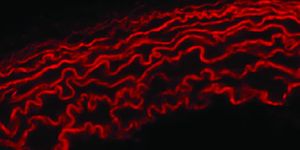Menopause Research Opens Door to new Hot Flash Treatment
Basic science may not always attract a lot of attention or funding, but it can lead to important conclusions with major impacts on many people. The work of Dr. Naomi Rance is one example. While she is personally affected by hot flashes like millions of other women, unlike those millions she has been doing basic research on menopause for a long time. She is a a physician and researcher at the University of Arizona College of Medicine - Tucson. Her new data on the role of estrogen in hot flashes could help develop therapeutics. Learn more about the work from the following video.
Rance has been interested in the physiology of menopause since her neuropathology fellowship. “I started off with a very straightforward project," she explains. "I was going to examine the hypothalamus in women's brains before and after the menopause. I found that a group of neurons got bigger in the brains of postmenopausal women and that was what was shocking at the time. Usually, with aging, things don't get bigger, they get smaller."
Established research had indicated that the arcuate nucleus of the hypothalamus - a cluster of neurons in the brain, was the site of the enlargement. The neurons in that region help control reproduction and contain the neuropeptide neurokinin B. Rance determined that these same neurons can affect how estrogen influences body temperature.
"That was really a sign that the reproductive axis is integrated with thermoregulation," Rance exaplined. "The two systems are intimately integrated." Rance confirmed it through experiments iby stimiulating the neurokinin B receptor - neurokinin 3, in rodents, which experienced a subsequent change in body temperature that mimicked a hot flash. Additional work showed that if neurokinin B receptors are ablated, thermoregulation is affected.
Rance and her team have suggested that a hot flash happens when estrogen levels drop. Low estrogen leads to an increase in the amount of neurokinin B that is released into areas of the brain that regulate body temperature. In theory, if the neurokinin 3 reveptor was blocked, the effect of neurokinin B woould be halted.
Dr. Waljit Dhillo, an Endocrinologist and Professor at Imperial College, London, heard these findings when Rance discussed them at the 2012 Second World Conference on Kisspeptin in Japan.
"Dhillo said that he and his colleagues heard the talk, and they realized that neurokinin 3 antagonists could be used as a treatment for hot flushes," Rance noted. "He took the idea to the clinical arena very fast. The first thing he did was infuse women with neurokinin B, and found that it caused hot flashes."
A recent clinical trial conducted by Dr. Julia Prague, Dhillo and colleagues, tested an antagonist of neurokinin 3 receptor, finding that the drug did indeed significantly reduce weekly hot flashes by 73 percent. The drug was also well tolerated, and could potentially be used instead of estrogen. That would be important espceially to women affected by estrogen-dependent breast cancer. Rance is pursuing her research of the underlying mechanisms of hot flashes.
"People think everything you do has to be translational, but I want to emphasize that it was basic research that has driven me all the way along," she said. "This would not have happened without the National Institutes of Health budget for basic research. You just don't know if something is going have a clinical application when you start."
Sources: AAAS/Eurekalert! via University of Arizona College of Medicine - Tucson, The Lancet








